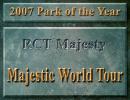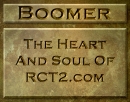|
Building a hypercoaster in RCT |
Section 1: The hills
|
How high to build the lift hill? Well, that partly depends on
how long the ride will be. A higher lift hill will be faster, more
intense and longer. It will also be more exciting if it is built
well. My favourite heights for hypercoasters are 46 & 52.
Ending the lift hill in a reasonably clear area is a good idea,
too. I like to start my first drop with the back of the train off
the lift hill. Either do this with a high straight section or a
high corner.
|
|
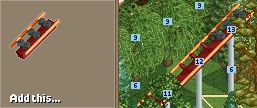
|
I've turned the track through 180º
outside the station because of space. Note that the lift hill is 1
launched then 2 normal track sections. This gives a fast lift hill
(about 15-20mph), with minimal intensity increase. However, the
bottom section needs to be normal or the trains will fall back
into the station. Also, running cost is higher.
|
|
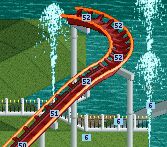
|
The lift hill has been a chain lift since height 47 to give a slow
(5mph) peak to keep intensity down. At height 52, this will be a
fairly fast coaster. The first drop comes down over a path in this
case, so I can't go underground for full speed.
|
|

|
Building
a peak in the track. This is the first peak after the lift hill,
so it is one steep section smaller.
|
|
So, you have a hypercoaster lift hill. Time to get exciting:
the first drop. All my hypers start with a hilly section, going
fast at the bottom & fairly slowly over the tops. Go straight
down from the top to as far down as possible – underground
even – to get great speed, intensity, excitement, and more
change of proper hypercoaster status. If there isn't room, or you
don't want those, then go down as low as you can. Then, it's
straight back up again. You should go up the height of one less
steep track section than you went down. Keep doing this for a
while. Note that steel twisters provide a smoother ride than steel
corkscrews, so they may become too fast. To avoid this, either go
the full way up, or build up one height unit after a main peak
(see just after the first bend on the hypercoaster in Vertigo
Views (LL only)).
|
|

|
The second drop comes down over clear water – perfect for going
down further. I need to remove water over that square.
|
|

|
Make space for a tunnel, then build the ride bottom. The ride then
comes out of a hillside in this case.
|
|
To turn, the best way is a steep twist at the top of a hill.
Note that placement will affect intensity – make sure it is
not too fast. If you are building a dueling coaster, either use
nested flat corners (different radii), or swap sides with steep
twists. Add an extra flat straight to one of the coasters, then
twist them in the same direction. The coasters will end up on
opposite sides of each other – check things work at the end
station. You can then re-synchronise by adding another flat
straight at the same speed (i.e. The same height if you do it soon
enough).
|
|
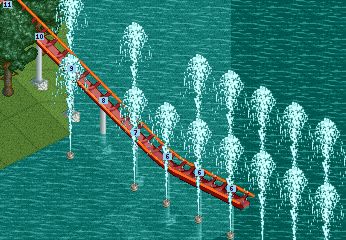
|
You can always add flat sections to a hypercoaster. Here the track
bends at height 11 & descends to water level and fountains.
|
|

|
This is the first twist on Sky Devil. One like this can be both
exciting & intense, so use it with caution.
|
|
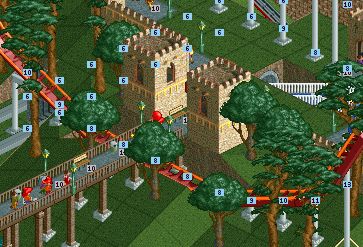
|
Remember,
going under a path is exciting & attracts more riders.
|
|
Once you feel that the trains have lost the speed needed for
hills, go on to section 2
|
|
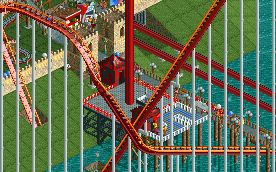
|
Here
is the drop to section 2 in Sky Devil. Note that the flat section
is to move the drop to somewhere there is space.
|
|
|
| This site © rcthelp 2002, 2003, 2004, 2005, 2006, 2007, 2008, 2009 and © sambo 2004, 2005,
2006, 2007, 2008, 2009. Rollercoaster
Tycoon™, Rollercoaster Tycoon 2™ and various images on this site are © Hasbro
Interactive, Infogrames Inc, Atari Inc and Chris Sawyer. Designed for screen resolutions of
800*600 or above and 16-bit colour. To get the best from the site, please configure
your browser to accept cookies and run Javascript. You can read our Privacy
Policy by clicking here,
and our Terms of Service here.
Contact webmaster@rct2.com for questions or other enquiries about
this site.
|
|


















